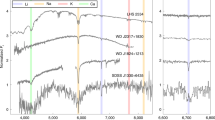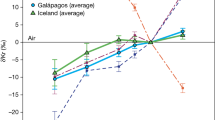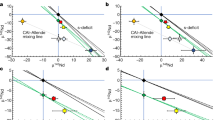Abstract
Chemical inertness and surface volatility, combined with low abundance, have made the rare (noble) gases a unique trace-elemental and isotopic system for constraining the formation and evolution of the solid Earth and its atmosphere1,2,3. Here I examine the implications of recent high-pressure measurements of the melting temperatures of heavy rare-gas solids—argon, krypton and xenon—with new diamond-anvil cell methods, together with their pressure–volume relationship, for the total rare-gas inventory of the Earth since its formation. The solid–liquid (melting) transition in these rare-gas solids rises significantly with pressure in the 50 GPa range4,5, such that melting temperatures will exceed the geotherm at pressures of the Earth's transition zone and lower mantle (depths greater than 410–670 km). The densities of condensed rare-gas solids obtained from recent pressure–volume measurements at high compressions also exceed Earth's mantle and core densities. These pressure-induced changes in the physical properties of rare-gas solids, combined with their expected low solubilities and diffusional growth mechanisms, suggest that dense solid or fluid inclusions of rare gases—initially at nanometre scales—would have formed in the Earth's interior and may have resulted in incomplete planetary degassing. Separation of dense solid inclusions into deeper regions during early planet formation could provide a straightforward explanation for the unexpectedly low absolute abundance of xenon observed in the atmospheres of both Earth and Mars.
This is a preview of subscription content, access via your institution
Access options
Subscribe to this journal
Receive 51 print issues and online access
$199.00 per year
only $3.90 per issue
Buy this article
- Purchase on Springer Link
- Instant access to full article PDF
Prices may be subject to local taxes which are calculated during checkout



Similar content being viewed by others
References
Ozima, M. Ar isotopes and Earth–atmosphere evolution models. Geochim. Cosmochim. Acta 39, 1127–1134 (1975).
Pepin, R. O. On the origin and early evolution of terrestrial planet atmospheres and meteoritic volatiles. Icarus 92, 2–79 (1991).
Allègre, C. J., Hofmann, A. & O'Nions, R. K. The argon constraints on mantle structure. Geophys. Res. Lett. 23, 3555–3557 (1996).
Jephcoat, A. P. & Besedin, S. P. Temperature measurement and melting determination in the laser-heated diamond-anvil cell. Phil. Trans. R. Soc. A 354, 1333–1360 (1996).
Jephcoat, A. P. & Besedin, S. P. in Properties of Earth and Planetary Materials at High Pressure and Temperature (eds Manghnani, M. H. & Yagi, T.) 287–296 (Geophys. Monogr. 101, Am. Geophys. Union, Washington DC, (1998)).
Akaogi, M. & Ito, E. Heat capacity of MgSiO3perovskite. Geophys. Res. Lett. 20, 105–108 (1993).
Young, D. A. Phase Diagrams of the Elements (University of California Press, Berkeley, (1991)).
Dziewonski, A. M. & Anderson, D. L. Preliminary reference Earth model. Phys. Earth Planet Inter. 25, 297–356 (1981).
Carroll, M. R. & Stolper, E. M. Noble gas solubilities in silicate melts and glasses: New experimental results for argon and the relationship between solubility and ionic porosity. Geochim. Cosmochim. Acta 57, 5039–5051 (1993).
Chamorro-Perez, E., Gillet, P. & Jambon, A. Argon solubility in silicate melts at very high pressures. Experimental set-up and preliminary results for silica and anorthite melts. Earth Planet. Sci. Lett. 145, 97–107 (1996).
Wiens, R. C. & Pepin, R. O. Laboratory shock emplacement of noble gases, nitrogen, and carbon dioxide into basalt, and implications for trapped gases in shergottite EETA 79001. Geochim. Cosmochim. Acta 52, 295–307 (1988).
Templier, C. in Fundamental Aspects of Inert Gases in Solids (eds. Donnelly, S. E. & Evans, J. H.) 117–132 (NATO ASI B279, Plenum, New York, (1991)).
Evans, J. H. & Mazey, D. J. Evidence for solid krypton bubbles in copper, nickel, and gold at 293 K. J.Phys. F: Met. Phys. 15, L1–L6 (1985).
Chandrasekhar, S. Stochastic problems in physics and astronomy. Rev. Mod. Phys. 15, 1–89 (1943).
Lux, G. The behavior of noble gases in silicate liquids: Solution, diffusion, bubbles and surface effects, with applications to natural samples. Geochim. Cosmochim. Acta 51, 1549–1560 (1987).
Ozima, M. & Podosek, F. A. Noble Gas Geochemistry (Cambridge University Press, UK, (1983)).
Caldwell, W. A. et al. Structure, bonding and geochemistry of xenon at high pressures. Science 227, 930–933 (1997).
Harper, C. L. & Jacobsen, S. B. Noble gases and Earth's accretion. Science 273, 1814–1818 (1996).
Tonks, W. B. & Melosh, H. J. in Origin of the Earth (eds Newsom, H. E. & Jones, J. H.) 151–174 (Oxford University Press, Oxford, (1990)).
Stevenson, D. J. Models of the Earth's core. Science 214, 611–619 (1981).
1. Martin, D. & Nokes, R. Crystal settling in a vigorously convecting magma chamber. Nature 332, 534–536 (1988).
Solomatov, V. S., Olson, P. & Stevenson, D. J. Entrainment from a bed of particles by thermal convection. Earth Planet. Sci. Lett. 120, 387–393 (1993).
Pepin, R. O. Evolution of Earth's noble gases: consequences of assuming hydrodynamic loss driven by giant impact. Icarus 126, 148–156 (1997).
Ozima, M. & Zahnle, K. Mantle degassing and atmospheric evolution: Noble gas view. Geochem. J. 27, 185–200 (1993).
Ozima, M., Wieler, R., Marty, B. & Podosek, F. A. Comparative studies of solar, Q-gases and terrestrial noble gases, and implications on the evolution of the solar nebula. Geochim. Cosmochim. Acta 62, 301–314 (1998).
Tolstikhin, I. N. & O'Nions, R. K. The Earth's missing xenon: A combination of early degassing and of rare gas loss from the atmosphere. Chem. Geol. 115, 1–6 (1994).
Zhang, Y. & Zindler, A. Noble gas constraints on the evolution of the Earth's atmosphere. J. Geophys. Res. 94, 13719–13737 (1989).
Ito, E., Morooka, K. & Ujike, O. Dissolution of K in molten iron at high pressure and temperature. Geophys. Res. Lett. 20, 1651–1654 (1993).
Wetherill, G. W. Radiometric chronology of the early solar system. Annu. Rev. Nucl. Sci. 25, 283–328 (1975).
Eldridge, M. D., Madden, P. A. & Frenkel, D. Entropy-driven formation of a superlattice in a hard-sphere binary mixture. Nature 365, 35–37 (1993).
1. Podosek, F. A. Solar gases in the Earth? Nature 349, 106–107 (1991).
Acknowledgements
I thank R. O. Pepin and M. Ozima for comments and discussion.
Author information
Authors and Affiliations
Rights and permissions
About this article
Cite this article
Jephcoat, A. Rare-gas solids in the Earth's deep interior. Nature 393, 355–358 (1998). https://doi.org/10.1038/30712
Received:
Accepted:
Issue Date:
DOI: https://doi.org/10.1038/30712
This article is cited by
-
Open questions on the high-pressure chemistry of the noble gases
Communications Chemistry (2022)
-
Primitive noble gases sampled from ocean island basalts cannot be from the Earth’s core
Nature Communications (2022)
-
Xenon iron oxides predicted as potential Xe hosts in Earth’s lower mantle
Nature Communications (2020)
-
The origin and fate of volatile elements on Earth revisited in light of noble gas data obtained from comet 67P/Churyumov-Gerasimenko
Scientific Reports (2020)
-
Fate of subducted argon in the deep mantle
Scientific Reports (2020)
Comments
By submitting a comment you agree to abide by our Terms and Community Guidelines. If you find something abusive or that does not comply with our terms or guidelines please flag it as inappropriate.



